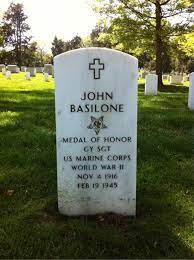John Basilone
Receiving the Congressional Medal of Honor for heroism and bravery at the Battle of Guadalcanal apparently wasn’t enough for a Marine Sergeant who loved his country. Sgt. John Basilone survived that battle and was awarded the medal in May, 1942.
But after serving a year in the United States as a former Marine advancing the sale of war bonds throughout the country, John Basilone once gain received permission to re-enlist in July 1943 and was assigned to “C” Company, 1st Battalion, 28th Marine Regiment,8th Marine Division,
Eighteen months later, February 19, 1945, the first day of the invasion of Iwo Jima he was serving as a machine gun leader on Red Beach II and once again showed his heroism. He was killed by a burst of small arms fire and for these actions, he was posthumously awarded the Marine Corps’ second highest decoration, the Navy Cross.
John Basilone is the only enlisted Marine who has been awarded the two highest honors for extraordinary heroism, the Congressional Medal of Honor and the Navy Cross during World War II.
The son of immigrant Italian parents, Basilone was born in Buffalo, NY and brought up in Raritan with his nine brothers and sisters, attended St. Bernard’s Catholic school, but worked as a caddy in a golf course rather than go to high school.
Enlisting in the Army in July 1934, when he was just over 18 years of age, Basilone served in that branch for three years, serving in the Philippines and gaining fame as a champion boxer. He was discharged after his enlistment period and re-enlisted once again the following day.
After that enlistment, he returned to Raritan and worked as a truck driver but wanted to go back into service. This time, he joined the Marine Corps.
He was deployed to Guantánamo Bay, Cuba, and in August 1942, took part in the invasion of Guadalcanal. He and the two machine-gun sections under his command held off an attack by a numerically far superior Japanese force in spite of great loss. Only four Marines survived that battle, including Basilone. It is for this action at this invasion he earned the Congressional Medal.
After the award presentation for his Guadalcanal actions, Basilone returned to Raritan and toured the country for the government promoting war bonds. He continued to apply to be returned to the Marine Corps in spite of his injuries.
He was offered a commission, but he declined it. He was offered an assignment as an instructor; again, he turned it down. When his request was finally approved, he went to Camp Pendleton for more training, and on July 3, 1944, he reenlisted in the Marine Corps.
In February 1945, he was killed in action on the first day of the invasion of Iwo Jima, after he single-handedly destroyed an enemy blockhouse and led a Marine tank under fire safely through a minefield. Including the Medal of Honor.
Basilone married his wife, Lena, a sergeant in the Marine Corps Women’s Reserve in July 1944. She never remarried after his death and died in 1999 at age 86. She is burred at Riverside National Cemetery in Riverside, California. Sgt. Basilone is buried at Arlington National Cemetery. His Medal of Honor is at the Marine Museum in Quantico, Virginia.
Sgt. Basilone has received numerous honors in his hometown, where there is an annual parade, the school gym is named in his honor and he is remembered annually in various ceremonies. Several military base streets, military facilities, and two United States Navy destroyers are named for him.
CITATION
For extraordinary heroism and conspicuous gallantry in action against enemy Japanese forces, above and beyond the call of duty, while serving with the 1st Battalion, 7th Marines, 1st Marine Division in the Lunga area, Guadalcanal, Solomon Islands, on 24 and 25 October 1942.
While the enemy was hammering at the Marines’ defensive positions, Sgt. Basilone, in charge of two sections of heavy machine guns, fought valiantly to check the savage and determined assault.
In a fierce frontal attack with the Japanese blasting his guns with grenades and mortar fire, one of Sgt. Basilone’s sections, with its gun crews, was put out of action, leaving only two men able to carry on. Moving an extra gun into position, he placed it in action, then, under continual fire, repaired another and personally manned it, gallantly holding his line until replacements arrived.
A little later, with ammunition critically low and the supply lines cut off, Sgt. Basilone, at great risk of his life and in the face of continued enemy attack, battled his way through hostile lines with urgently needed shells for his gunners, thereby contributing in large measure to the virtual annihilation of a Japanese regiment.
His great personal valor and courageous initiative were in keeping with the highest traditions of the U.S. Naval Service.
